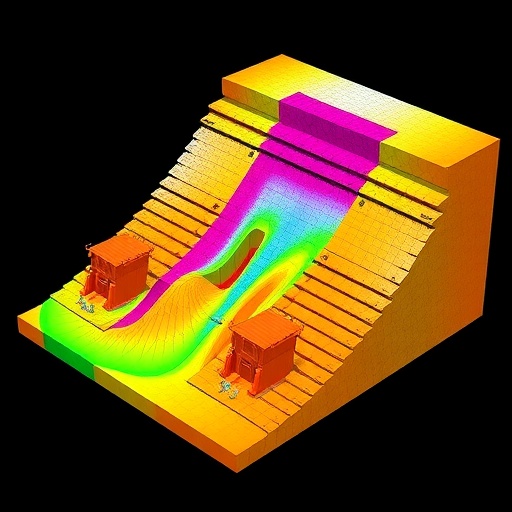In an era where sustainable mining practices are becoming paramount, the challenge of accurately predicting surface subsidence remains a critical concern for both researchers and industry professionals. Surface subsidence—ground deformation resulting from underground mining—can lead to significant environmental and structural hazards. Recently, a pioneering study published in Environmental Earth Sciences has introduced a novel model that promises to revolutionize how we anticipate and mitigate the effects of subsidence, particularly in complex geological settings involving thick loose overburden layers. This breakthrough, developed by Zhang, Zhu, Yang, and colleagues, offers dynamic prediction capabilities that align more closely with real-world conditions than ever before.
The problem of surface subsidence intensifies in mining operations where grouted backfill is used. Grouted backfill, a practice that involves injecting a slurry mixture into mined-out voids, is designed to stabilize underground cavities and reduce ground movement. However, despite its benefits, the behavior of overlying strata, especially thick loose layers, introduces variability that existing models struggle to accommodate. Traditional approaches often simplify or ignore the dynamic interactions between backfill materials and overburden strata, leading to inaccurate predictions and unexpected surface deformation.
What sets this new model apart is its comprehensive approach to representing the coupled mechanics of grouted backfill and thick loose surface layers. The researchers leveraged advanced numerical methods to capture the time-dependent evolution of stress and strain within these heterogeneous strata, resulting in a dynamic predictive framework. This framework accounts for the gradual stiffening and consolidation of backfill materials, as well as the non-linear deformation characteristics of loose overburden layers, thus offering unprecedented accuracy in forecasting subsidence progression.
Utilizing empirical data from various mining sites, the authors calibrated their model to reflect real-world sedimentation and mechanical properties. Their results demonstrated remarkable concordance between predicted and observed subsidence patterns, highlighting the model’s robustness. By simulating scenarios with varying thicknesses and material compositions of loose layers, the study underscored how such geological complexity can dramatically influence subsidence magnitudes and patterns, which are crucial for the safety of surface infrastructure.
The practical implications of this research are profound. Surface subsidence not only threatens buildings, roads, and pipelines but also alters hydrological regimes and promotes ecosystem disruption. By accurately predicting subsidence over time, mining companies can optimize backfill injection strategies, improve safety protocols, and plan surface land use with more certainty. This dynamic model offers a valuable decision-support tool that balances resource extraction with environmental stewardship.
Moreover, the incorporation of time-dependent behavior in the model addresses a significant limitation of existing prediction techniques. Surface subsidence is not a static event but a process that evolves as the backfill cures and interacts mechanically with the surrounding rock masses. The model captures these temporal effects by simulating mechanical property changes post-injection, something rarely addressed with such precision in prior research.
Another innovative aspect lies in the stratigraphic consideration of thick loose layers. These layers can behave unpredictably, especially under varying moisture conditions and load redistributions caused by mining activities. The model integrates these factors by coupling geotechnical properties of loose sediments with the dynamic stress transfers induced by mining and backfill operations, offering a more holistic representation of surface dynamics.
Environmental Earth Sciences’ publication of this work places it at the intersection of cutting-edge geomechanics and sustainable mining practices. The research team’s interdisciplinary collaboration spanned geotechnical engineering, material science, and environmental geology, reflecting the multifaceted nature of the challenge. This holistic understanding enables the model not only to predict immediate subsidence but also to forecast long-term surface stability, a feature crucial for post-mining land reclamation planning.
The enhanced predictive capability also facilitates regulatory compliance and risk management. Mining operations are increasingly subject to stringent environmental assessments and monitoring requirements. By providing a scientifically validated tool that anticipates surface deformation with high fidelity, the model helps companies meet these standards while minimizing economic liabilities arising from damage claims or remediation efforts.
Furthermore, the studies’ comprehensive numerical framework is adaptable to various geological contexts beyond the initial case studies. The authors emphasize that their model can be tailored to different mining methods, rock mass conditions, and backfill mixtures, making it a versatile asset for global mining industries that face diverse geotechnical challenges.
Future applications of this model include integration with real-time monitoring systems, enabling dynamic updates and predictive alerts during mining operations. Such advancements could drive next-generation intelligent mining frameworks where subsidence predictions inform automated adjustments in backfill injection parameters, optimizing safety and operational efficiency simultaneously.
This work also opens new avenues for academic research, particularly in further investigating the microscale interactions within grout-backfill-rock systems and their macroscale manifestations as surface deformations. It serves as a foundational reference for developing more comprehensive, multiscale models that couple geomechanical, hydrological, and chemical processes influenced by mining and backfilling activities.
In summary, the innovative dynamic prediction model presented by Zhang and colleagues addresses a long-standing challenge in mining geomechanics with both scientific rigor and practical value. By capturing the complex interplay between grouted backfill and thick loose overburden layers over time, it significantly enhances our ability to anticipate and manage surface subsidence—a critical step towards more sustainable and responsible mining operations worldwide.
As the mining industry confronts mounting environmental pressures and the imperative of minimizing land disruption, such advances in predictive modeling will be key to balancing resource extraction with ecological and infrastructural preservation. The model’s dynamic nature, adaptability, and robust validation mark it as a pioneering tool poised to influence both academic research and practical mining applications for years to come.
Subject of Research: Dynamic prediction of surface subsidence induced by grouted backfill mining in geological settings characterized by overlying thick loose layers.
Article Title: A model for dynamic prediction of surface subsidence due to grouted backfill mining with overlying thick loose layers.
Article References:
Zhang, Q., Zhu, L., Yang, K. et al. A model for dynamic prediction of surface subsidence due to grouted backfill mining with overlying thick loose layers. Environ Earth Sci 84, 686 (2025). https://doi.org/10.1007/s12665-025-12696-1
Image Credits: AI Generated




